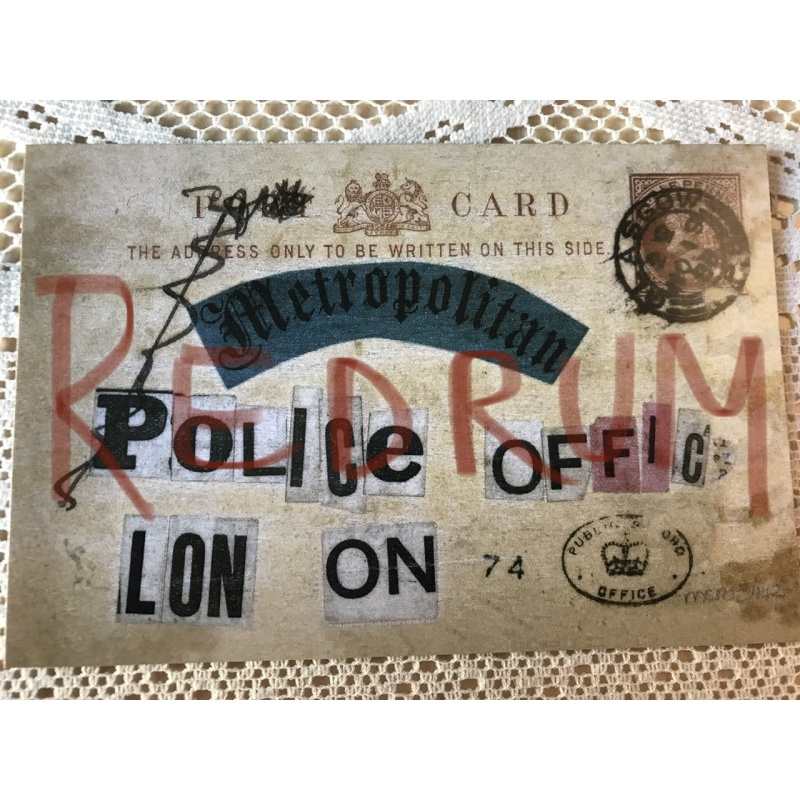ID: 736599
Open
Jack the Ripper postcard to Metropolitan police office Nov 1888
Redrumautographs 738
Glasgow postcard November 1888
$17.50
- Postage
-
$5.00 to United States
Regular mail
Get Additional Rates
- Select Country
- Zip/Post Code
- Quantity
$20.00
1 watching
13 views
No bids posted.
Description
Jack the Ripper postcard to Metropolitan police office Nov 1888
You will get a reproduction of this postcard
Possible Details of the Glasgow Postcard
- Date and Origin: This postcard is said to be postmarked from Glasgow in 1888. It was sent to the Metropolitan Police Office in London.
- Content: The postcard reportedly starts with a reference to the “Whitechapel atrocities,” which aligns with the language used in other Ripper letters. The mention of stickers and letters glued to the back door of the postcard is unusual and not commonly seen in other Ripper correspondence.
- Significance: If authentic, this postcard would be significant as it would indicate that the sender was aware of the Whitechapel murders and was attempting to communicate with the police from outside London. This could suggest a broader geographical awareness or movement of the sender.
Historical Context
- Whitechapel Murders: The Whitechapel murders occurred in the East End of London in 1888, with the most infamous being attributed to Jack the Ripper. The murders were characterized by extreme brutality and the killer’s ability to evade capture.
- Correspondence: During the time of the murders, the police and newspapers received numerous letters claiming to be from the killer. Many of these were dismissed as hoaxes, but a few, like the “Dear Boss” letter and the “Saucy Jacky” postcard, were taken more seriously due to their detailed content and timing.
Current Views
- Authenticity: The authenticity of many of these letters, including the Glasgow postcard, remains debated. Some experts believe that many of the letters were hoaxes, possibly written by journalists or pranksters to keep the story in the public eye.
- Forensic Analysis: Modern forensic techniques, such as handwriting analysis and linguistic studies, have been applied to some of the letters, but conclusive evidence linking any of them definitively to the actual killer has not been found.
Payments & Returns
- Payment Methods
- PayPal
Postage & Shipping
- Item Location
- H4K 2T2, New York, United States
- Ships To
- Worldwide
- Pick-ups
- No pick-ups
- Returns Accepted
- No
Redrumautographs 738
Cary Stayner 8.5 x 11 artwork signed Cary from 2010
Cary Stayner Yosemite killer 8.5 x 11 artwork signed Cary from 2010This artwork of a wild is done in pencil on a white 8.5 x 11 paper. It’s signed Cary 10.
$225.00
0 bids
Redrumautographs 738
Annie Chapman postmortem 2.75 x 3.5 phograph Jack the Ripper 1888
Jack the Ripper Victim no.2 Whitechapel 1888
$12.50
0 bids
Redrumautographs 738
John Wayne Gacy polaroid in Menard Correctional Facility signed from 1990
Deathrow shot of John Gacy with Rick Staton 10/31/1990
$1,950.00
0 bids
Redrumautographs 738
Bill Suff 4 x6 X-ray photograph of victim’s pelvis showing how he inserted a light bulb
Bill Suff 4 x6 X-ray photograph of victim’s pelvis showing how he inserted a light bulbThis is not an actual X-ray but a photograph of an X-ray . It was obtained among other photographs years backed.
$10.00
0 bids







